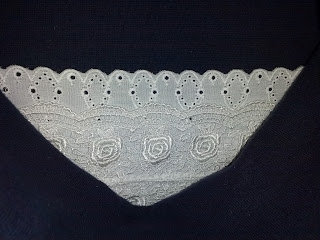I don't have any project updates, but want to share something I've been thinking about.
We are fortunate enough to live at a time when, if you don't want to get all of your food from the large-scale industrial/commercial farming system, there are alternatives. It is possible for people to get fresh, local, organic vegetables and fruits from farmers' markets, locally baked breads and pastries, and even meat from animals that have been raised humanely/responsibly and without use of antibiotics, hormones, etc. In other words, there are alternative food sources for people who don't want to participate in the agricultural-industrial complex.
There don't seem to be many alternative sources for people who want to "opt out" when it comes to clothing. Sure, there are a few places that sell hippie organic cotton (or hemp, or bamboo) t-shirts and pants, and American Apparel and New Balance and a handful of other companies still manufacture in the U.S., but there isn't the widespread availability of alternative sources like you have for food. The few sources that do exist don't exactly cover the fashion spectrum, especially for those of us who like to dress chic or fashionably. And American Apparel and New Balance aren't exactly "local" or "community supported" in the same sense that a farmer's market or farming cooperative is. The vast majority of ready-to-wear clothing bought in the U.S. is made in a factory overseas, where the cost of manufacturing is lower (and the working conditions are potentially sub-par).
The slow-food movement has a lot of devotees. Alice Waters has her own cult following. Michael Pollan's books have been national bestsellers.
Yet when it comes to clothing there isn't any movement out there of the same scale promoting the same kind of ideology.
I did a quick Google search and found that in the spirit of slow-food, slow-clothing was founded in 2006, but it didn't seem to take off to the same extent as slow-food.
I think it is worthwhile to re-approach the idea of celebrating clothing made from environmentally sound materials, made in conditions that don't entail human suffering, and made to fit.
About that last bit. Clothing is really best tailored to fit the wearer's body. It's amazing how much of a difference it makes when clothes actually fit right. Celebrities and the rich are well aware of this and have all of their clothing tailored.
The ready-to-wear items that most people buy often don't fit that well, because people come in all sizes and shapes, and the clothing doesn't. Ready-to-wear clothes are made based off of what the clothing industry thinks will fit the average person, but few of us can take something off the rack and have it fit perfectly. Unless you happen to be the same size and shape as the fit model, there is likely going to be at least one area that doesn't fit right. Maybe the waist is too roomy, but the hip and thigh area is tight, or you are too short and the pants/dress/skirt needs to be hemmed. Maybe clothing companies don't even make clothes in your size (anybody who is super petite or on the taller/larger side can sympathize with this).
I started this blog to document my progress towards making my own clothes, with some of these thoughts in my mind.
Not everyone who is frustrated with the modern clothing and fashion industry is similarly interested in making their own clothes. Why aren't there alternatives for them? Is it because it is not economically viable? Am I mistaken in thinking that some people would happily pay more for "slow-clothing"? And I don't mean Parisian couture-house prices (think Chanel, Christian Dior, Givenchy, Jean Paul Gaultier, etc.), I mean prices that regular people could afford to pay.
I'd like to explore this in tandem with my forays into clothing-making, but I'm not exactly sure how to approach it.
My husband thinks we should make machines that make perfectly tailored clothes. You feed the machine your measurements (or better yet, the machine measures you) and the machine creates the clothes, removing the human labor component. It seems like a pretty cool idea, but you might lose out on the special one-of-a-kind feeling you get from something handmade...










































